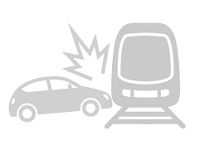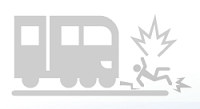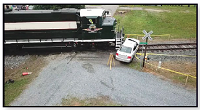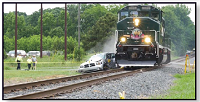Railway-Highway Crossings (Section 130) Program
NOTEWORTHY PRACTICE
Education Efforts to Reduce Railway Fatalities
An Abundance of Innovative Resources and Ideas


FHWA-SA-19-038

1,790
Annual average of collisions at public railway-highway crossings

222
Annual average of fatalities at public railway-highway crossings
Incorrect driver behavior is the number one reason for railway crossing collisions. According to the Federal Railroad Administration (FRA), an annual average of 1,790 collisions and 222 fatalities occurred at public railway-highway crossings from 2009-2018.1
Education is an effective way to help reduce these numbers and ensure drivers, pedestrians, and emergency responders are aware of the dangers of being on and around railroad tracks. Many States and organizations are producing engaging and effective outreach strategies emphasizing that it is not only what you say—it is how you say it and who you say it to.
Education and Outreach Partnership


Source: NCDOT
Mock crash videos demonstrate importance of railroad safety.
Operation Lifesaver (OLI) is a nonprofit organization providing public education programs in States to prevent collisions, injuries, and fatalities on and around railroad tracks. OLI offers numerous resources for States and communities to help improve safety around railroads. OLI believes in the power of telling a targeted and intentional story about rail safety. Its year-round communication efforts involve outreach nationwide including 44 States and the District of Columbia. OLI provides public awareness campaigns, educational initiatives, and training for professional drivers, law enforcement, and emergency responders. OLI's State coordinators also offer free safety presentations to communities through their network of volunteers.
One example of OLI's education efforts demonstrated a poignant message. The State OLI program of North Carolina partnered with North Carolina Department of Transportation (NCDOT) to perform and record a staged crash between a vehicle and a train.2 The train was traveling at 25 mph, well below typical speeds for freight and passenger trains. The mock crash demonstrated the damage caused when a train collides with a motor vehicle, and the potential for fatal or serious injuries to the driver and passengers, even at this lower speed. The dramatic live demonstration and resulting videos were an innovative way for OLI and NCDOT to educate about the danger near railroads.

Source: NCDOT
Railroad Safety Campaigns
NCDOT's efforts go beyond the mock train crash demonstration to create a railroad safety campaign. North Carolina branded its campaign BeRailSafe and developed a dedicated web page to provide tools for communicating the risks associated with railways. The web page features targeted outreach materials, including safety tips, public outreach campaign information, and free first responder training. BeRailSafe resources are grouped by target audience, including children, adults, and first responders, making it easy to find the right piece of outreach material for the right audience.
A national campaign called Stop. Trains Can't was launched in 2017 by FRA and the National Highway Traffic Safety Administration (NHTSA). The goal of the 3-year campaign is to increase public awareness and reduce crossing deaths and injuries around railroad tracks. The campaign features visually engaging and downloadable banners, fact sheets, animated graphic interchange formats (GIFs), radio ads, media buy plans, infographics, example news releases, and other communications material templates. The materials are provided in both English and Spanish, allowing the campaign to reach a wide audience.
Targeted Approach
The State OLI programs of Georgia and Kansas created materials targeting professional photographers to educate about unsafe photography practices around railroad tracks. In addition to targeting photographers, Kansas also created a flyer to specifically inform high school officials about the dangers and legality of seniors posing on or near railroad tracks for yearbook portraits. It encourages schools to not accept or publish yearbook portraits taken on railroad property.3
The FRA found that 59 percent of grade crossing crashes involve drivers between the ages of 20 and 49.4 To target such an important demographic, the State OLI program of Wyoming placed advertisements in event programs for Professional Bull Riders Association competitions, which typically attract this high-risk group in their State.
Video Outreach
Ryan's Brain videos educate young drivers.
With teens spending numerous hours a day watching videos on mobile phones, a video-based campaign is an effective way to reach teen drivers. Keeping that in mind, OLI created a video series called Ryan's Brain5 to educate new drivers about safe ways to interact with railways. The videos provide train facts, information about what to do at crossings, and how to drive near trains.
States and other transportation organizations are also creating videos to grab the attention of targeted audiences. Some noteworthy videos include:
- Iowa Department of Transportation created an infographic-style video to demonstrate the value of freight trains to the public and remind drivers that while they have the ability to detour, train conductors do not.6
- Connecticut Department of Transportation (CTDOT) Operation Lifesaver Program partners with schools to do safety presentations for school bus drivers, teens, and children. A variety of videos, ranging from cartoons to deadly crashes, are used to help convey the safety message. CTDOT also partners with the Department of Motor Vehicles to display OLI rail safety education videos.7
- The National Safety Council created a provocative video showing past crashes to encourage drivers to respect the speed of a trains.8
1 Federal Railroad Administration Dashboard web site, accessed February 2020, https://railroads.dot.gov/safety-data. [ Return to note 1. ]
2 NCDOT, "Crash Simulation Drone," https://vimeo.com/272650324, and "Train vs Car Crash Simulation," https://vimeo.com/272644314, Vimeo videos, accessed October 2019. [ Return to note 2. ]
3 These materials can be found on Operation Lifesaver's website, https://oli.org/materials. [ Return to note 3. ]
4 FRA, In Depth Analysis of Grade Crossing Accidents Resulting in Injuries and Fatalities, (Washington, DC: USDOT, May 2017). [ Return to note 4. ]
5 Operation Lifesaver, "Ryan's Brain videos," accessed October 2019, https://oli.org/safety-near-trains/driving-safely-near-tracks/new-drivers. [ Return to note 5. ]
6 Iowa DOT, "Brief Bother Big Benefit — You Can Detour, Trains Can't," YouTube video, accessed October 2019, https://youtu.be/f2eOfynbmNk. [ Return to note 6. ]
7 Kevin Burns (Connecticut Department of Transportation), phone interview, October 25, 2019. [ Return to note 7. ]
8 National Safety Council, "Never Attempt to Beat a Train," YouTube video, accessed October 2019, https://youtu.be/9etFdBu_urA. [ Return to note 8. ]
Page last modified on May 13, 2020

